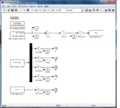Controls/Lab/Instrumentation
This page contains information related to the Instrumentation Basics and Simulink Lab for Controls. It has been updated for Spring, 2012.
Contents
Typographical Errors / Clarifications
- Due to timing issues, you will only actually be able to get through Assignment 2 in the first lab period (Feb 1-2). Once you are finished with Assignment 2, be sure to transfer the files you need to your OIT account. You will complete things during Feb 8-9.
- For the initialization of MATLAB, when the first window comes up about platforms, click the "Do Not Ask Again" option and then click the RTI1104 button. If a window comes up about incompatible settings, select the do not ask again option, then Set Automatically. This should take care of the settings in the Simulink configuration for working with the dSPACE cards -- but you should still check the configuration as given on page Lab 3-11.
- In ControlDesk, the assumption is that the icon bars look similar to the one here:

If not, you likely have several tools open that do not need to be. In the ControlDesk View menu, select Toolbars - the image above was obtained with the following toolbars on:
- Controldesk
- Interpreter
- Experiment Manager
- Instrumentation
- Platform Manager
- Bus Manager
- and all the other toolbars off. The toolbar with the edit/test/animation buttons is the Instrumentation toolbar.
- To complete Assignment 3 during 2/8-2/9, you will want to log in to a PC, create an InstrumentationLab folder on the desktop of the PC you are on, and have one of the partners use the SSH File Transfer program to bring all the files from last week back onto the PC. Be sure to start MATLAB and ControlDesk and note that the model for Assignment 3 (a) looks like a combination of the models for Assignments 1 and 2 and (b) is pictured below. Do not forget to go through the Simulink Configuration Settings for your new model, however!
Resources
- Relevant Pundit pages
- dSPACE - which includes link to templates for DAC and ADC
- Files for the lab:
Codes, Models, and Layout Images
Since you should never copy and paste text from a PDF (the quotes change and extra spaces are added), some of the code for the assignment parts will be included below. Also, there are pictures of the models and layouts that you will be building.
Assignment 1: RC Circuit Analysis
InitInstruments1.m
%% Initialize workspace
clear; format short e;
%% Sets global parameters
global Ts SR
% Defines sampling rate and - more importantly - sample time
SR = 1000;
Ts = 1/SR;
%% Opens and builds Simulink Model on dSPACE
ModelName = 'Instruments1'
open_system(ModelName)
rtwbuild(ModelName)
MakeInstrument1Handles.m
%% Select the board
mlib('SelectBoard', 'ds1104');
%% Define global variables for measurement and output channels
global ADC1 ADC5 DAC1 CONST
global Ts SR
%% Create handles to relevant blocks
ADC1 = mlib('GetTrcVar', 'Model Root/ADC1/In1');
ADC5 = mlib('GetTrcVar', 'Model Root/ADC5/In1');
DAC1 = mlib('GetTrcVar', 'Model Root/DAC1/In1');
CONST = mlib('GetTrcVar', 'Model Root/C1/Value');
Assignment 2: Angular Measurements
InitAngMeasurement.m
%% Initialize workspace
clear; format short e;
%% Sets global parameters
global Ts SR
% Defines sampling rate and - more importantly - sample time
SR = 10;
Ts = 1/SR;
%% Opens and builds Simulink Model on dSPACE
ModelName = 'AngMeasurement'
open_system(ModelName)
rtwbuild(ModelName)
The following are links to larger images of the Simulink model and ControlDesk layout for Assignment 2 of this lab:
Assignment 3: Voltage Control
Questions
Post your questions by editing the discussion page of this article. Edit the page, then scroll to the bottom and add a question by putting in the characters *{{Q}}, followed by your question and finally your signature (with four tildes, i.e. ~~~~). Using the {{Q}} will automatically put the page in the category of pages with questions - other editors hoping to help out can then go to that category page to see where the questions are. See the page for Template:Q for details and examples.
External Links
- AMT 102 & 103 DIP Switch Resolution Settings from CUI.com via amtencoder.com.



